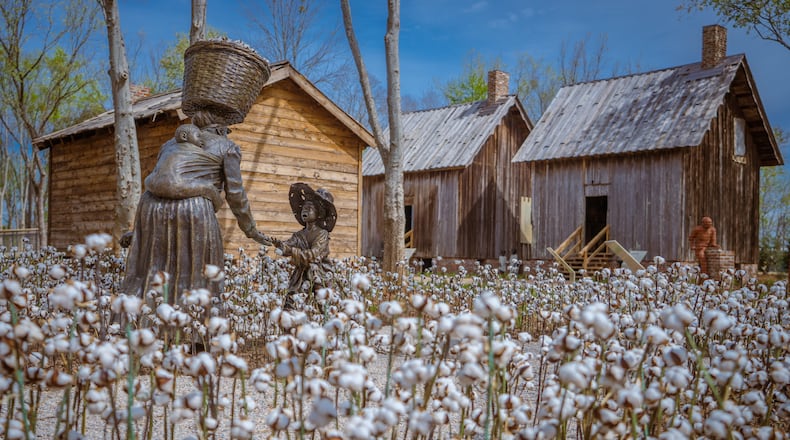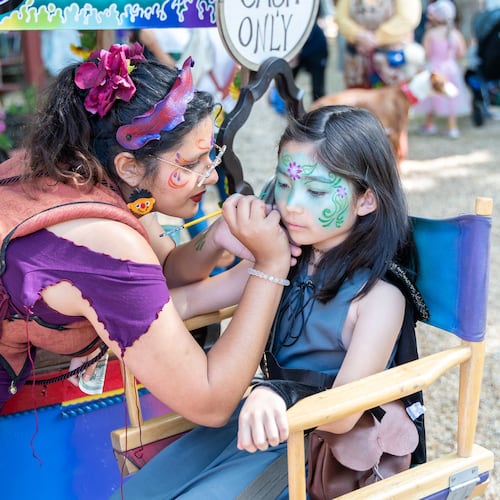MONTGOMERY, Alabama — A light breeze sends ripples down the sun-dappled Alabama River. From this perch on the bluff it is hard to imagine this gently meandering stretch of the 318-mile waterway was the main artery where thousands of enslaved Africans were trafficked into and out of the state throughout the 19th century.
Now visitors can travel by boat along the same route to arrive at Freedom Monument Sculpture Park, which opened in March in Montgomery, Alabama.
The park occupies 17 acres of land along the riverbank bordered by rail lines that enslaved people built, then were forced to ride as chattel. The park, the third cultural site created by Bryan Stevenson and his team at the Equal Justice Initiative (EJI), features historical artifacts, written first person narratives, and sculptures by 35 artists.
Designed to honor the millions of people who endured the horrors of slavery, Freedom Monument Sculpture Park also aims to fill the gaps in our education about the lives of enslaved people and to signal a more hopeful future.
Credit: Equal Justice Initiative ∕ Human Pictures
Credit: Equal Justice Initiative ∕ Human Pictures
“We’ve done a very poor job in the United States of honestly educating people about the most difficult parts of our history,” said Stevenson, founder and executive director of EJI, a Montgomery-based human rights organization. “Few people truly understand the brutality of slavery and the legacy it created for continuing racial injustice. Racial terror violence and lynching is virtually ignored in American textbooks, and we tend to minimize the challenges our history of racial injustice has created. So, monuments, memorials and public history are vital in correcting a real deficit in our collective understanding of our past.”
The centerpiece of the park is a 43-feet high, 155-feet-long monument inscribed with more than 122,000 surnames chosen by 4 million Black people freed after the Civil War. The 1870 census, the first year Black Americans were listed by full name rather than by first name or a number, was acquired and digitized. A QR code helps visitors locate their surnames on the monument.
Credit: Equal Justice Initiative ∕ Human Pictures
Credit: Equal Justice Initiative ∕ Human Pictures
“This space gives us an opportunity to honor and celebrate those who endured slavery and survived to give birth to descendants who have done so many remarkable things. So little has been done to recognize the extraordinary character, witness and perseverance of enslaved people in this country,” Stevenson said. “The National Monument to Freedom is an opportunity to name, acknowledge and celebrate ancestors.”
Stevenson said Freedom Monument Sculpture Park serves as a complement to the two cultural sites he launched in 2018.
The Legacy Museum traces the trans-Atlantic slave trade through the Reconstruction era to Jim Crow and segregation. Interactive exhibits and narratives help visitors understand and connect the history of exclusion, mistreatment and racial bias toward Black people to modern day mass incarceration.
The nearby National Memorial for Peace and Justice is a 6-acre space dedicated to the remembrance of racial terror and its victims. The names of these victims and the locations of their lynchings are etched into 6-foot rectangular steel monuments that hang suspended from above as visitors walk down a gentle slope.
Freedom Monument Sculpture Park is located just north of the Museum, accessible via a 20-minute walk, a free shuttle and by boat that launches from the downtown Riverwalk. As with all the Legacy Sites, it brings an authenticity that can’t be ignored — an intense look at slavery and its attendant ills that refuses to offer a comforting viewpoint. In this serene, wooded landscape, tragedy and beauty are constant companions.
From the start, visitors are confronted with dramatic and powerful works of art reflecting on the Black experience, including newly commissioned works from Alison Saar along with major sculptures from Simone Leigh, Rose B. Simpson, Kehinde Wiley and Hank Willis Thomas.
Credit: Equal Justice Initiative ∕ Human Pictures
Credit: Equal Justice Initiative ∕ Human Pictures
“Art has the unique ability to animate the brutality and cruelty of slavery while depicting the humanity and resolve of those enslaved,” said Stevenson. “Engaging in difficult topics like slavery, lynching and segregation can be challenging, but art has a way of mediating the difficulty of the history with moments of beauty and inspiration.”
The striking “Black Renaissance” by London-based artist Rayvenn D’Clark is comprised of a series of 9-foot-tall bronze busts of a woman, man and children that “honor the multiplicity of the Black experience, a symbolic reminder of our ongoing struggle against racial injustice in many countries across the world,” said D’Clark in March.
Credit: Equal Justice Initiative ∕ Human Pictures
Credit: Equal Justice Initiative ∕ Human Pictures
Ghanaian artist Kwame Akoto-Bamfo’s figurative groupings chronicle a family of enslaved people who have just arrived in the Americas. The family is later depicted working in the cotton fields where a young child has pricked a finger on the sharp cotton bolls.
Context is important and no exploration of American history would be complete without recognition and acknowledgment of the indigenous communities that first populated these spaces. The narrative of racial difference that has plagued our nation from its beginnings was cultivated when Europeans engaged Indigenous peoples who had occupied these lands for centuries, Stevenson said.
“Most of the public acknowledgment of Native people begins with the arrival of Europeans, and we felt it was important to challenge that framing,” he said. “The site of our Park was sustained and managed by Indigenous people for centuries, and we felt it was essential to acknowledge that.”
The Equal Justice Initiative commissioned Cliff Fragua’s “Three Sisters” a 7-foot tall sculpture in Tennessee marble that was inspired by the artist’s themed series on corn, beans and squash. It is one of several sculptures depicting the Indigenous experience along with historical narratives detailing the struggle for Indigenous rights and the forcible removal of Indigenous people from the land.
Historically significant objects and structures such as a whipping post where Black people were beaten and tortured are also important elements of the Park. Visitors can walk inside three 170-year-old plantation dwellings reclaimed from the Faunsdale Plantation about 75 miles west of Montgomery. The dwellings, some of which were in use well past midcentury, are still papered with cardboard boxes and old newspapers as insulation.
Credit: Equal Justice Initiative ∕ Human Pictures
Credit: Equal Justice Initiative ∕ Human Pictures
The replica of a rail car from the 19th century demonstrates how enslaved people were moved from place to place, while a holding pen, which visitors can enter, gives insight into the conditions enslaved people had to endure while awaiting their destiny.
These experiential moments and the beauty of the visual art set the Freedom Monument Sculpture Park apart from EJI’s other cultural sites as well as some of the other art and educational installations focused on Black history that have cropped up across the country in recent years.
For Stevenson, this retelling of Black history in ways that are both unflinching and accessible has become an important part of EJI’s mission.
In his decades-long career as an attorney, Stevenson — whose work resulted in the release of death row inmate Walter McMillian in 1993, and was documented in his 2014 book “Just Mercy” and the 2019 film starring Michael B. Jordan and Jamie Foxx — came to realize that justice wasn’t blind, but the court system was turning a blind eye to racial bias. He blames America’s failure to confront and address its history of racial violence. Other countries (South Africa, Germany) had confronted their racist histories, but America seems stuck on repeat, recounting the same narratives that glorify rather than expose our troubled past.
Stevenson could no longer remain silent about the evils of the domestic slave trade and lynching. He broadened the scope of Equal Justice Initiative’s work by collecting comprehensive data on a range of topics related to Black enslavement, lynching and incarceration. That research would become the foundational work for the Legacy Sites.
“At this moment, there is so much fear and anger shaping our political environment,” Stevenson said. “James Baldwin once said that fear aligned with power is the greatest threat to justice. Our abiding commitment to justice requires us to confront the ignorance that shapes so many of the misguided policies and practices, so the Legacy Sites have become central to our work.”
After visiting plantations across the American South he found they romanticized the era of slavery. The plantations elevated the opulence and wealth of enslavers as if these conditions were honorable and admirable. Stevenson believed he needed to create a space that offered historical authenticity and centered the story of slavery around the lives and perspectives of enslaved people.
In Montgomery, like many other cities in the South, there is still a struggle to give a more honest framing of the past, he said. Part of his effort to change that framing is placing emphasis on the narrative power of the art and artifacts as well as offering first-person accounts in text printed on large-scale panels.
The narratives share stories of enslaved people and their efforts to escape, to live and to love under the terror of slavery. Those stories are balanced by the writings of Black abolitionists, writers and thinkers who explored similar themes in prose and poetry.
Credit: Matt Odom
Credit: Matt Odom
Stevenson doesn’t like to leave room for misinterpretation so visitors will also find hard data on the location of human trafficking ports out of Africa and into the States and the number of people who passed through these points. There is also an area with large panels inscribed with old slavery laws from states throughout the country revealing how the lives of enslaved people was codified.
Only in reclaiming and retelling these stories — through art, artifact and text — can we begin the process of reconciliation and repair, Stevenson said.
“I do think the presence of these new cultural sites creates a new understanding of why we can and should do better in thinking more critically about what’s honorable and what is not,” he said.
IF YOU GO
Legacy sites. 9 a.m.-5 p.m., Wednesday-Sunday. $5 grants access to all sites. The Legacy Museum entry is timed; entry to the National Memorial and Freedom Monument is good any day. 334-386-9100, legacysites.eji.org.
Freedom Monument Sculpture Park. 831 Walker St., Montgomery, Alabama.
The Legacy Museum. 400 N. Court St., Montgomery, Alabama.
The National Memorial for Peace and Justice. 417 Caroline St., Montgomery, Alabama.
About the Author
Keep Reading
The Latest
Featured









